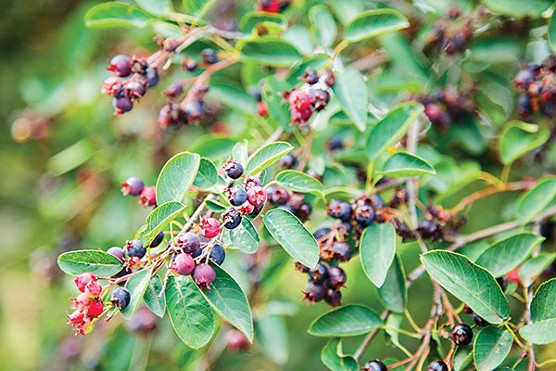Each June, Stephanie Dax looks forward to harvesting juneberries across the Pittsburgh region. These wild berries look like blueberries and have a taste similar to “sweet black cherries,” according to, where else, www.juneberries.org.
You might also know the tasty treat as a shadbush, shadblow, Saskatoon berry or by one of several other monikers. Dax, a local forager, doesn’t actually care what you call them — just leave some for everybody else.
A few weeks ago, Dax came across a group of juneberry trees in Homestead, but when she returned a few days later to harvest some — the fruit is perfect for jams, pies and other baked goods — the trees had been picked clean.
“If you’re going to take something from a juneberry tree, you should take some, but it should basically look like you haven’t been there,” says Dax whose philosophy stems from a background in trail work. “If there’s not a huge supply, then maybe you shouldn’t take it.”
Over the past few years, foraging has emerged as a popular hobby and foraged foods are a draw for local restaurants. But its growing popularity is starting to cause problems for longtime foragers and wildlife as native plants are stripped in greater quantities.
“If it’s going to become popular, I think people need to understand how to respect the environment,” says Dax. “It’s not just respecting the environment so other people can enjoy it, but birds and other animals need to eat that. It’s definitely a concern.”
Adam Haritan is a Pittsburgh forager who leads classes, walks and workshops for Phipps Conservatory, local school districts and private groups.
“I got into it kind of through health and nutrition because I was learning how to take care of myself,” says Haritan. “I wanted to feel better than I’ve ever felt before, and I found out some of the healthiest foods out there aren’t the ones in the grocery store, but the ones that are actually growing in places where humans didn’t intend them to grow.”
In Haritan’s sessions, rules of sustainable foraging are some of the first things participants learn. He also gives out native species for participants to plant to ensure they aren’t just taking from the land, but also giving back.
“We focus on sustainability with almost every single plant we talk about,” says Haritan. “It’s not like I throw out a general rule; it’s different for every single plant. Some of them are native, some are invasive, some of them can do very well with more human disturbance and some of them can’t take it at all.”
While foraging is certainly growing in popularity, Haritan says he doesn’t see its popularity creating problems. Instead, he says the availability of some plants is being negatively impacted by habitat loss from development and the oil and gas industry.
“I really don’t see too much damage being done by individuals. It’s usually on a large scale when a company will just come and clear land, or a new housing development’s going in or a new strip mall,” says Haritan. “I think one area that could potentially be a problem is with commercial foragers, those who go out and want to sell it to restaurants or ship it overseas.”
Haritan says he doesn’t have a problem with commercial foraging as long as it’s done in a sustainable manner.
And that’s Justin Lubecki’s philosophy. Lubecki forages for personal use and has also worked for several Pittsburgh restaurants, including Legume, B52, Bread and Salt, and Franktuary.
“One of the first things I learned to forage for are morel [mushrooms]. Aside from the all-important understanding of what it looks like and where to find it, there’s no question that when you go foraging for morels, you bring a basket or a mesh bag,” says Lubecki. “The point of that is when you pick them and you’re walking along the trail, spores are dropping, so there’s more morels coming back next year.”
One plant that has suffered from growing popularity is ramps, a wild onion that grows in Appalachia. Foraging for ramps has been outlawed in some parks around the country due to shortages. Lubecki says that when he learned of the craze locally, he stopped selling ramps to the restaurants he works with.
“You have to think about the multiple years it takes certain things to regenerate,” says Lubecki. “You’ll come upon places, and you’ll see signs of over-picking. As this sort of grows in popularity, I hope people are aware that if you take an absurd amount of something, you have to go home and process it, and that’s a lot of work. Be realistic about what you can handle and that what you’re taking from is providing food and nutrients for wildlife.”
Despite the potential problems, local foragers say they aren’t trying to steer newcomers away from the hobby.
“If you don’t have a big garden of your own, you can use the rest of the environment around you as a garden in some ways. It gets you out of the space you’re in when you’re searching for things and that allows you to explore. And the things that you find are so tasty,” says Dax. “A lot of foragers keep the secrets of things they find for the very reason [that] they’re afraid people will over-harvest them. But sharing the ideas of sustainable foraging would make it so everyone can share in these great finds.”















